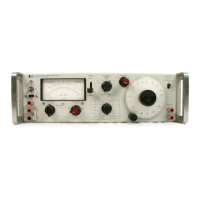Model
333A/334A
Section
III
meter indication.
Set
METERRANGE
switch
down-scale
as
necessary to keep meter
in-
dication on scale.
n.
Repeat step
m
until
no further reduction
in
meter indication can
be
obtained.
0.
Observe distortion
either
in
percentage or
dB,
as
indicated
by
meter deflection and
METER RANGE
switch setting.
For
example,
if
meter indicates
0.4
and
METER
RANGE
setting
is
18,
distortion measured
is
0.4%
of
fundamental. Similarly,
if
meter
indi-
cates
-6
dB
and
METER RANGE
setting
ie
-40
dB, distortion measured
is
-46
dB from
fundamental.
NOTE
In
MANUAL
mode
the
accuracy
of
distortion measurements
is
affected
by
frequency stability
of
the input
signal.
An
inaccuracy
in
distortion indications occurs
when
the
frequency
drift
of
the
input
signal
exceeds
the
bandwidth
of
the rejection curve.
p.
If
desired, rms voltage of
input
signalcan
be
measured
by
setting
FUNCTION
switch to
VOLTMETER,
and
setting
METER
RANGE
switch
to
obtain
an on-scale indication.
3-20. AUTOMATIC
MODE.
a
b.
C.
d.
e.
f.
Perform steps athroughlof Paragraph
3-19.
Adjust frequency
dial
vernier and
BALANCE
COARSE
and
FINE
control8 for minimum
meter indication.
When meter indication
is
less than
10%
of
SET LEVEL
indication,
set
MODE
switch to
AUTOMATIC.
(If
fundamental cannot
be
manually
nulled below
10%
of
SET LEVEL
indication, automatic mode cannot
be
used).
Set
METER RANGE
switch down-scale to
obtain on-scale meter indication.
Observe distortion either in percentage
or
dB,
as
indicated
by
meter deflection and
METER RANGE
switch
setting.
For example,
if meter indicates
0.4
and
METER RANGE
setting
is
18,
distortion measured
is
0.4%
of
fundamental. Similarly,
if
meter indicates
-6
dB
and
METER RANGE
setting
is
-40
dB,
distortion measured
is
-46
dB from funda-
mental.
If
desired, rms voltage of input
signal
canbe
measured
by setting
FUNCTION
switch to
VOLTMETER,
and
setting
METER RANGE
switch to obtain
an
on-scale indication.
3-21. DISTORTION MEASUREMENT OF
AM
RF
CARRIERS
(334A
only).
DO
NOT EXCEED
MAXIMUM
INPUT
VOLTAGES LISTED ON
REAR
PANEL.
a.
Turn instrument
on
and
mechanically zero
meter according to procedure
in
Paragraphs
3-15
and
3-16.
b.
Set
NORM.-R
F.
DET.
switch to
R.
F.
DET.
c.
Connect input
signal
to
R
F.
INPUT
terminal
on rear panel.
Refer
to Paragraph
3-19
for manual distort-
ion measurement;
refer
to
Paragraph
3-20
for
automatic distortion measurement.
d.
NOTE
If
no
meter deflection can
be
obtained with
an
RF
input,
diode
A4CR1
should
be
checked.
A
spare diode
is
located on
the
outside
of
the
A4
shield.
3-22. VOLTAGE MEASUREMENT.
a.
Turn instrument on and mechanically zero
meter according to procedure in Paragraphs
3-15
and
3-16.
b.
Set
NORM.-R.
F.
DET.
switch to
NORM.
c.
Set
FUNCTION
switch to
VOLTMETER.
6
Set
METER RANGE
switch to
a
range
exceeding amplitude
of
signal to
be
mea-
sured.
e. Connect
signal
to
be
measured to
INPUT
terminals.
f.
Set
METER RANGE
switch to give a reading
as
close to
full
scale
as
possible, and
ob-
serve meter indication.
g. The dB scale
of
the
333A/334A
is
calibrated
in
dBm, such
that
0
dBm =
1
milliwatt
dissi-
pated
by
600
ohms.
Therefore,
a
dBm mea-
surement must
be
made across
600
ohms.
However,
dB
measurements
across
other
impedances can
be
converted to dBm
by
use
of
the Impedance Correction Graph of
Fig-
ure
3-3.
For example: to convert
a
-30
dB
reading
across
200
ohms
to dBm, locate the
200
ohm
impedance line
at
the bottom
of
the
graph.
heavy
black
line, and
read
the
meter correc-
tion
at
that
point. The correction for
200
ohms
is
+5
dBm;
thus
the
corrected reading
is
-25
dBm.
3-3
Follow the impedance
line
to
the

